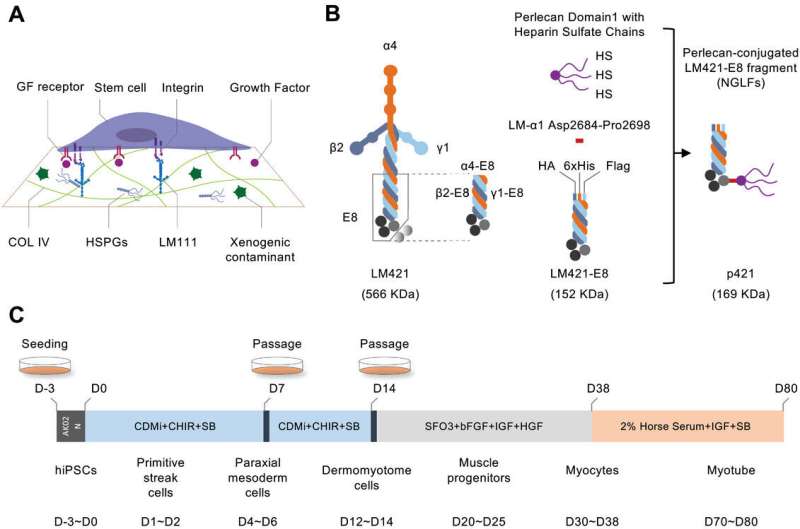
Since their discovery, researchers have repeatedly demonstrated the potential medical applications of differentiated cells and tissues generated from induced pluripotent stem (iPS) cells. However, a significant hurdle to real-world medical applications is related to the substrate used to culture and induce iPS cells into differentiated cell types.
In particular, while differentiation protocols generating myocytes and muscle stem cells (MuSCs) from iPS cells have been reported, they remain relatively low in efficiency and require using a popular animal-derived substrate called Matrigel.
Moving forward, more efficient induction protocols and a shift toward xeno-free (without animal-derived products) substrates capable of ensuring cost-effectiveness, reproducibility, and safety are necessary.
To this end, a collaborative team from Japan has combined their expertise to design and validate a new recombinant extracellular matrix protein, named new generation laminin fragments (NGLFs), for differentiating iPS cells into muscle cell lineages.
The results of this study were published in Advanced Science on April 29, 2024.
Previous studies have established recombinant laminin E8 (LM-E8) fragments as a minimal substrate for iPS cell cultures, but they do not support myogenic differentiation. To identify an LM-E8 variant capable of supporting myocyte and MuSC generation from iPS cells, the team tested various laminins with different compositions but found them to support only drastically lower levels of myogenic differentiation.
The researchers reasoned that perlecan, a multifunctional heparan sulfate proteoglycan (HSPG) core with multiple heparan sulfate chains in Matrigel, may be vital to its ability to support various molecular interactions necessary for optimal iPS cell maintenance and differentiation and thus designed a LM-E8 attached to the perlecan domain 1 with three HS chains (D1-HS).
The researchers observed significant improvements in myogenic differentiation by attaching this modification to the C-termini of LM-E8 variants. In particular, the p421 isoform showed the best improvement, even better than Matrigel, so the researchers focused on using this isoform for generating myocytes and MuSCs.
By examining differentiation markers at various stages (i.e., primitive streak (PS), paraxial mesoderm (PM), and dermomyotome (DM)), the research team confirmed that not only NGLFs are superior to corresponding LM-E8 variants in promoting stage-specific marker gene expression, p421 consistently support better differentiation than any other NGLFs tested.
Notably, the researchers found p421 to specifically support differentiation to the PM stage, as no beneficial effects were observed from p421 following PM formation. Furthermore, using heparitinase (to degrade HS chains) and surfen (to inhibit HS-mediated interactions), they deduced the beneficial effects of p421 to derive primarily from the HS moiety.
In addition, by blocking multiple signaling receptors and their downstream intracellular effectors, they determined that p421 works principally through the bFGF-FGFR-EGF pathway to promote PM induction. Gene expression analysis further indicated that this signaling supported HOX gene expression to promote undifferentiated iPS cells toward the PS stage.
To demonstrate the importance of conjugation orientation between LM-E8 and D1-HS, the researchers generated p421 variants by attaching the HS moiety to the N-terminal end of the β- or γ-chain of LM-E8. Although these variants increased stage-specific marker gene expression, p421 showed substantially stronger effects by comparison.
From these findings, the research team concluded that p421 likely aids FGFR signaling by bringing HS-bound FGFs closer to the cell surface to promote FGFR dimerization.
Finally, to illustrate how p421 improves myogenic differentiation and overcome inconsistencies plaguing current induction protocols, the research team generated disease and control iPS cell lines for two forms of muscular dystrophy, Duchene muscular dystrophy (DMD) and Miyoshi myopathy (MM).
As expected, p421 supported greatly improved myogenic differentiation from all the iPS cell lines examined. Furthermore, the researchers found that p421 improved myogenic differentiation across several commonly used culture media.
In summary, the research team successfully created a recombinant proteoglycan substrate that supports significant enhancements in myogenic differentiation and demonstrated its underlying mechanism.
It is hoped that NGLFs will help establish highly efficient, xeno-free differentiation protocols to generate iPS cell-derived muscle cell lineages for medical applications against various myopathies.
More information:
Mingming Zhao et al, Heparan Sulfate Chain‐Conjugated Laminin‐E8 Fragments Advance Paraxial Mesodermal Differentiation Followed by High Myogenic Induction from hiPSCs, Advanced Science (2024). DOI: 10.1002/advs.202308306
Citation:
Designing a novel substrate for myogenic differentiation from induced pluripotent stem cells (2024, May 7)
retrieved 7 May 2024
from https://phys.org/news/2024-05-substrate-myogenic-differentiation-pluripotent-stem.html
This document is subject to copyright. Apart from any fair dealing for the purpose of private study or research, no
part may be reproduced without the written permission. The content is provided for information purposes only.







